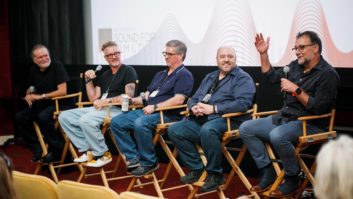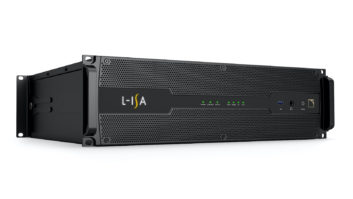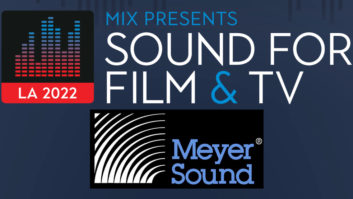
New York, NY (July 16, 2020)—On October 16, 1972, a Cessna carrying two U.S. Congressmen, an aide and a pilot disappeared on a flight from Anchorage, Alaska, bound for the state capital of Juneau. No wreckage was ever found despite a 39-day search by the government, the men were never heard from again and the case has never been solved.
Despite drifting from the headlines decades ago, investigative reporter Jon Walczak is still chasing leads for the long-shuttered case. Through his podcast Missing in Alaska, he aims to put every listener in the search with him. That mission begins with creative sound design.
“I really wanted something atmospheric, something to evoke Alaska or Arizona or wherever we are,” says Walczak, creator and narrator of the iHeartRadio podcast. “Or, if it’s a period in time, evoke the early ’70s with Watergate and Vietnam, or Alaska during the oil boom.”

From the first moments of the podcast, the audio production team drops listeners right into the story. An archival media report sets up the disappearance like a dispatch from a parallel world, carrying the distant, sepia-toned sonics of the time period. A portentous wind sweeps across the mix, and a subtle synth builds tension under Walczak’s storytelling.
“We really wanted to establish that tone from the get-go,” says supervising producer Paul Dechant. “[But] one of the tricks for us as the editors is finding that balance between what’s enough sound design, what’s enough music and where it is too much.”
The art of sound design is in making those choices. Producer Seth Nicholas Johnson is able to bounce among a number of audio sources that have their own characteristics, including interviews recorded in person, over the phone or via video conference, to create the soundscape.
 “We definitely like the texture of all the different kinds of recordings that we have,” says Johnson. “We love to cut back and forth between things that have been recorded in the field and things that were recorded through Skype and archival recordings.”
“We definitely like the texture of all the different kinds of recordings that we have,” says Johnson. “We love to cut back and forth between things that have been recorded in the field and things that were recorded through Skype and archival recordings.”
Even though the production team had easy access to the deep iHeartRadio sound libraries, the environmental touches that connect listeners to place and setting in Missing in Alaska are the real deal. When they needed sounds to represent the idea of lowering a search boat into the water, for example, they would simply reference their own collection of curated audio.
“It’s like, ‘Okay, we’re building Alaska, we’re painting a picture of this three-day trip and this search, there’s no need to pretend that just a random soundscape of the ocean that I found online was the Pacific Ocean,’” says Johnson.
Dechant traveled with a Zoom H6 recorder and a Sennheiser shotgun mic for field interviews and sound-capture opportunities like the search boat. When they had the chance for a sit-down interview—which they did in Arizona, where they tracked down mobsters who have ties to the case—he relied on a Shure SM7b, the same microphone Walczak used to track his narration.

Walczak originally set out to record his narration at a studio in Atlanta, but he only made it three episodes into the series before the COVID-19 pandemic scuttled those plans and scattered the production team. The host went back to his home in New Orleans and set up a small table with a microphone in his closet and started recording there.
“The thing I like best about the production is that it’s very hard to tell the difference between the closet setup and the professional studio,” says Johnson. “A big part of it is the disrupted walls—having all the clothing and blankets at different angles shoots back the audio in uneven waves, so it makes it all perfect.”
Each episode takes about a week to put together after Walczak has scripted and recorded his narration. Dechant and Johnson have a tag-team style where they take turns leading production on an episode. They edit in Adobe Audition, since they were already familiar with the Adobe ecosystem from working in video, and lean on iZotope RX to reign in certain elements of the archival audio and interviews.
Bootstrapping Audio Production for ‘Out Alive’
Reverse Engineering with the ‘Song Exploder’ Podcast
“There have definitely been some clips from the past where it’s like, ‘Oh no, this is hard to listen to. How are we going to clean this up?” explains Johnson. “[iZotope RX] is the main program we use for de-noising and reverb, but not sanitizing to the point that it sounds like a vocoder. Making sure it still has that grit and tape hiss. It’s an old recording; it should sound like an old recording.”
Walczak, a traditional journalist and writer, found the open-ended format of a podcast liberating. He’s not bound to a word count or the finality of a longform story. It also fits his larger mission, which is to actually solve the case. He maintains a spreadsheet of contacts that contains more than 500 entries, and he invites listeners who may have information related to the case to send tips.
“It’s just an absolutely overwhelming amount of information [involved in the case], and that gets to why I wanted help from the audience,” says Walczak. “The request for help, the idea to make it interactive, it’s not a gimmick.”
Missing In Alaska • https://www.iheart.com/podcast/1119-missing-in-alaska-62503099/







